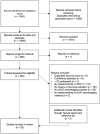Associations between neurovascular coupling and cerebral small vessel disease: A systematic review and meta-analysis
- PMID: 37697725
- PMCID: PMC10683738
- DOI: 10.1177/23969873231196981
Associations between neurovascular coupling and cerebral small vessel disease: A systematic review and meta-analysis
Abstract
Purpose: The pathogenesis of cerebral small vessel disease (cSVD) remains elusive despite evidence of an association between white matter hyperintensities (WMH) and endothelial cerebrovascular dysfunction. Neurovascular coupling (NVC) may be a practical alternative measure of endothelial function. We performed a systematic review of reported associations between NVC and cSVD.
Methods: EMBASE and PubMed were searched for studies reporting an association between any STRIVE-defined marker of cSVD and a measure of NVC during functional magnetic resonance imaging, transcranial Doppler, positron emission tomography, near-infrared spectroscopy or single-photon emission computed tomography, from inception to November 3rd, 2022. Where quantitative data was available from studies using consistent tests and analyses, results were combined by inverse-variance weighted random effects meta-analysis.
Findings: Of 29 studies (19 case-controls; 10 cohorts), 26 reported decreased NVC with increasing severity of cSVD, of which 18 were individually significant. In 28 studies reporting associations with increasing WMH, 25 reported reduced NVC. Other markers of cSVD were associated with reduced NVC in: eight of nine studies with cerebral microbleeds (six showing a significant effect); three of five studies with lacunar stroke; no studies reported an association with enlarged perivascular spaces. Specific SVD diseases were particularly associated with reduced NVC, including six out of seven studies in cerebral amyloid angiopathy and all four studies in CADASIL. In limited meta-analyses, %BOLD occipital change to a visual stimulus was consistently reduced with more severe WMH (seven studies, SMD -1.51, p < 0.01) and increasing microbleeds (seven studies, SMD -1.31, p < 0.01).
Discussion and conclusion: In multiple, small studies, neurovascular coupling was reduced in patients with increasing severity of all markers of cSVD in sporadic disease, CAA and CADASIL. Cerebrovascular endothelial dysfunction, manifest as impaired NVC, may be a common marker of physiological dysfunction due to small vessel injury that can be easily measured in large studies and clinical practice.
Keywords: Blood-oxygen-level-dependent (BOLD); cerebral small vessel disease; endothelial function; functional neuroimaging; neurovascular coupling.
© European Stroke Organisation 2023.
Conflict of interest statement
Declaration of conflicting interestsThe author(s) declared no potential conflicts of interest with respect to the research, authorship, and/or publication of this article.
Figures






References
-
- Ganna A, Ingelsson E. 5 year mortality predictors in 498,103 UK biobank participants: a prospective population-based study. Lancet 2015; 386: 533–540. - PubMed
-
- Wardlaw JM, Benveniste H, Williams A. Cerebral vascular dysfunctions detected in human small vessel disease and implications for preclinical studies. Annu Rev Physiol 2022; 84: 409–434. - PubMed
Publication types
MeSH terms
Grants and funding
LinkOut - more resources
Full Text Sources

